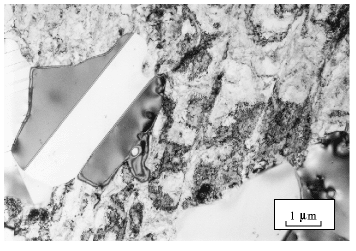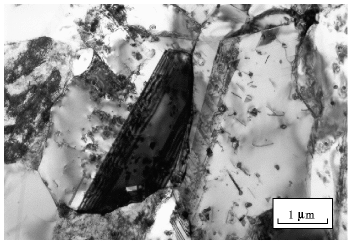
Shows a recrystallised grain which is relatively free of dislocations, surrounded by a deformed matrix which has a high dislocation density. The recrystallised grain contains annealing twins (parallel bands with different contrast).

Some discussion of recrystallization can be found in a series of lectures available online. A full discussion of stainless steels is also available.
Transmission electron micrographs taken at 200 kV, from a thin foil sample of "302AA" austenitic stainless steel. The sample was cold-deformed by rolling and then annealed at 704 oC for one hour. All images show partially recrystallised microstructures. The recrystallised grains are clean (largely free from defects) whereas the deformed regions show a large concentration of defects such as dislocations and cell boundaries. There are annealing twins in the recrystallised regions.
 |
A mixture of deformed and recrystallised grains. |
| Superalloys | Titanium | Bainite | Martensite | Widmanstätten ferrite |
| Cast iron | Welding | Allotriomorphic ferrite | Movies | Slides |
| Neural Networks | Creep | Mechanicallly Alloyed | Theses | Retained Austenite |
| PT Group Home | Materials Algorithms |